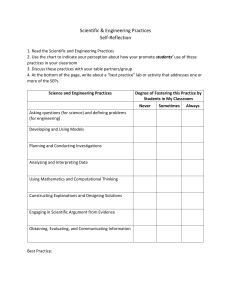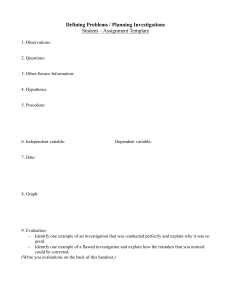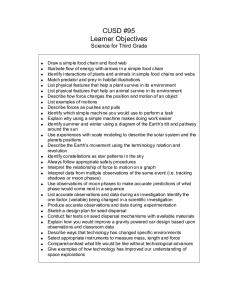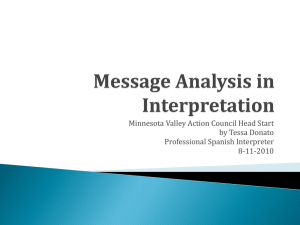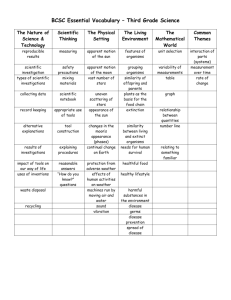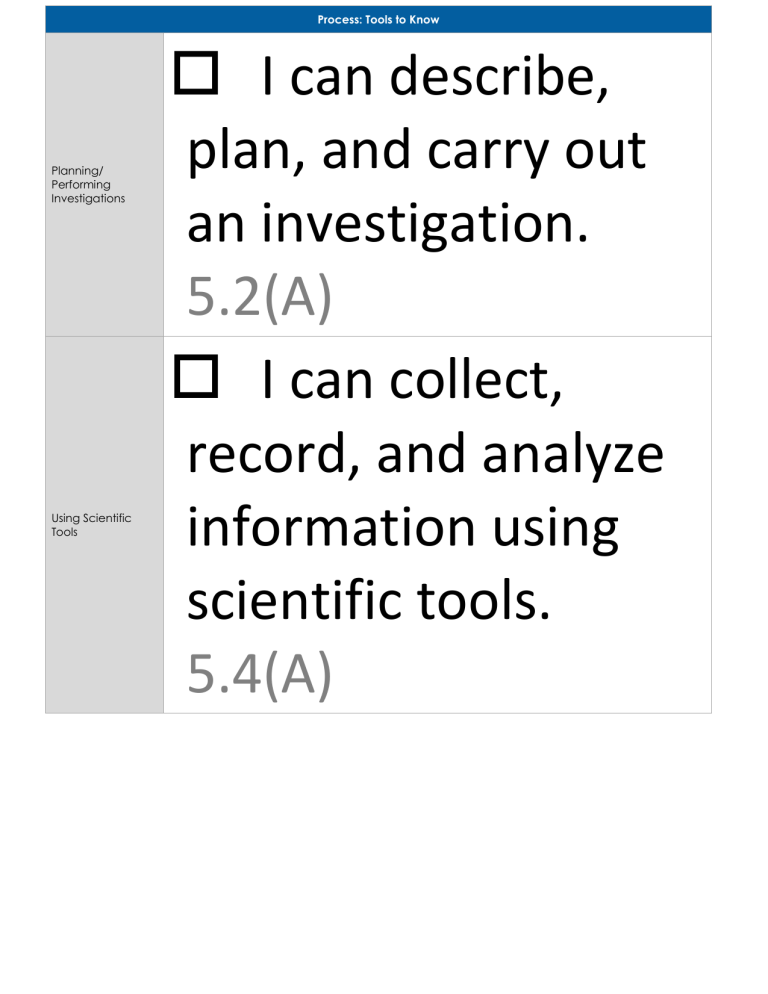
Process: Tools to Know Planning/ Performing Investigations Using Scientific Tools I can describe, plan, and carry out an investigation. 5.2(A) I can collect, record, and analyze information using scientific tools. 5.4(A) I can classify matter based on measurable, testable, and observable physical properties. 5.5(A) mass □magnetism □ physical state (solid, liquid, and gas) □relative density (sinking and floating using water as a reference point) □solubility in water □the ability to conduct or insulate thermal energy or electric energy □ Properties of Matter Changes in Matter Mixtures I can predict, observe, and record changes in the state of matter caused by heating or cooling. 3.5(C) I can demonstrate that some mixtures keep the physical properties of their ingredients. 5.5(B) I can identify changes that can occur in the physical properties of the ingredients of solutions. 5.5(C) Uses of Energy Electricity Light I understand the uses of different kinds of energy. 5.6(A) □mechanical □light □thermal □electrical □sound I can demonstrate how the flow of electricity in closed circuits can produce light, heat, or sound. 5.6(B) I can demonstrate how light travels in a straight line until it strikes an object and is reflected. 5.6(C) I can demonstrate how light travels through one medium to another and is refracted. 5.6(C) I can design an investigation that tests the effect of force on an object. 5.6(D) Force I can observe and show how position and motion can be changed by pushing and pulling objects. 3.6(B) Process: Ways to Show Interpreting Information Constructing Models I can analyze and interpret information and give a reasonable explanation based on the evidence. 5.2(D) I can construct graphics that help me organize, examine, and evaluate information. 5.2(G) I can make a model to show how something works or looks. 5.3(B) Earth Process: Tools to Know Planning/ Performing Investigations I can describe, plan, and carry out an investigation. 5.2(A) Using Scientific Tools I can collect, record, and analyze information using scientific tools. 5.4(A) Content Notes Check Up Notes Check Up Notes Check Up I can explain the processes that led to the formation of sedimentary rocks. 5.7(A) Rocks and Soil I can describe properties of soils. 4.7(A) color and texture capacity to retain water ability to support the growth of plants I can recognize how landforms such as deltas, canyons, and sand dunes are formed as the result of changes to Earth's surface by wind, water, or ice. 5.7(B) Landforms I can explain how rapid changes in the Earth’s surface happen. 3.7(B) volcanic eruptions earthquakes landslides I can explain the processes that led to the formation of fossil fuels. 5.7(A) Renewable and Nonrenewable Resources I can identify and classify Earth’s renewable resources. 4.7(C) air plants water animals I can identify and classify Earth’s nonrenewable resources. 4.7(C) coal oil natural gas I can explain the importance of conservation. 4.7(C) Process: Ways to Show Interpreting Information I can analyze and interpret information and give a reasonable explanation based on the evidence. 5.2(D) Constructing Models I can make a model to show how something works or looks. 5.3(B) Weather Process: Tools to Know Planning/ Performing Investigations I can describe, plan, and carry out an investigation. 5.2(A) Using Scientific Tools I can collect, record, and analyze information using scientific tools. 5.4(A) Content Notes Check Up Notes Check Up Notes Check Up I can differentiate between weather and climate. 5.8(A) Weather I can measure, record, and predict changes in weather. 4.8(A) I can explain how the Sun and the ocean interact in the water cycle. 5.8(B) Water Cycle I can describe and illustrate the continuous movement of water above and on the surface of Earth through the water cycle. 4.8(B) I can explain the role of the Sun as a major source of energy in the water cycle. 4.8(B) Process: Ways to Show Observing and Measuring Interpreting Information Constructing Models I can collect and record information using detailed observations and accurate measuring. 5.2(C) I can analyze and interpret information and give a reasonable explanation based on the evidence. 5.2(D) I can construct graphics that help me organize, examine, and evaluate information. 5.2(G) I can make a model to show how something works or looks. 5.3(B) Space Process: Tools to Know Planning/ Performing Investigations I can describe, plan, and carry out an investigation. 5.2(A) Using Scientific Tools I can collect, record, and analyze information using scientific tools. 5.4(A) Content Notes Check Up Notes Check Up Notes Check Up I can demonstrate how the Earth rotates on its axis once approximately every 24 hours causing the day/night cycle and the apparent movement of the Sun across the sky. 5.8(C) Rotation of the Earth I can collect and analyze data to identify sequences and predict patterns of change. 4.8(C) shadows seasons the observable appearance of the Moon over time Sun, Earth, and Moon I can identify and compare the physical characteristics of the Sun, Earth, and Moon. 5.8(D) Planets I can identify the planets in Earth’s solar system and their position in relation to the Sun. 3.8(D) Process: Ways to Show Interpreting Information I can analyze and interpret information and give a reasonable explanation based on the evidence. Constructing Models I can make a model to show how something works or looks. 5.3(B) 5.2(D) Organisms and Environments Process: Tools to Know Using Scientific Tools Notes Check Up Notes Check Up Notes Check Up I can collect, record, and analyze information using scientific tools. 5.4(A) Content I can explain how organisms live and survive in their ecosystem by interacting with the living and nonliving components. 5.9(A) I can predict the effects of changes in ecosystems caused by living organisms, including humans. 5.9(C) Interactions in Ecosystems overpopulation of grazers building of highways I can identify fossils as evidence of past living organisms and the nature of the environments at the time using models. 5.9(D) I can describe the physical characteristics of environments and how they support populations and communities of plants and animals within an ecosystem. 3.9(A) Food Webs I can observe and describe the flow of energy within a food web. 5.9(B) role of the Sun role of producers role of consumers role of decomposers Process: Ways to Show Interpreting Information I can analyze and interpret information and give a reasonable explanation based on the evidence. Constructing Models I can make a model to show how something works or looks. 5.3(B) 5.2(D) Adaptations and Behaviors Process: Tools to Know Planning/ Performing Investigations I can describe, plan, and carry out an investigation. 5.2(A) Using Scientific Tools I can collect, record, and analyze information using scientific tools. 5.4(A) Content Adaptations I can compare the structures and functions of different species that help them live and survive in a specific environment. 5.10(A) hooves on prairie animals webbed feet in aquatic animals Inherited Traits and Learned Behaviors I can differentiate between inherited traits of plants and animals and learned behaviors. 5.10(B) Life Cycles I can describe and compare how animals and plants undergo a series of orderly changes in their diverse life cycles. 3.10(B) tomato plants frogs lady beetles Process: Ways to Show Interpreting Information I can analyze and interpret information and give a reasonable explanation based on the evidence. Constructing Models I can make a model to show how something works or looks. 5.3(B) 5.2(D) Notes Check Up Notes Check Up Notes Check Up
